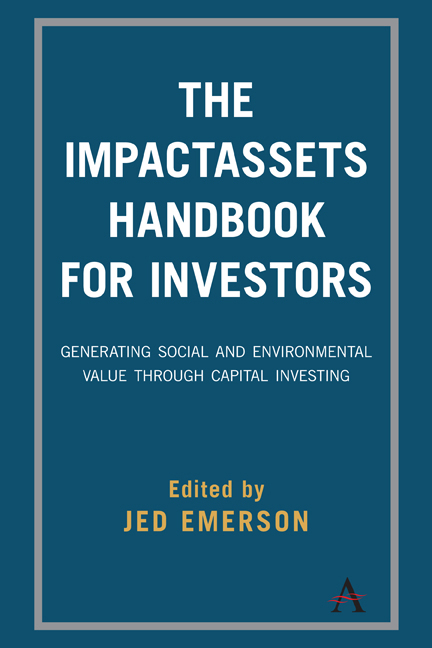 The ImpactAssets Handbook for Investors
The ImpactAssets Handbook for Investors Book contents
- Frontmatter
- Dedication
- Contents
- List of Contributors
- Preface
- Introduction
- 1 Construction of an Impact Portfolio: Total Portfolio Management for Multiple Returns
- 2 Total Portfolio Management: One Practitioner's Approach
- Case Study 1
- Case Study 2
- 5 Targeted Impact: Donor-Advised Funds and Impact Investing
- 6 Transformational Giving: Philanthropy as an Investment in Change
- 7 Assessing Your Opportunities: The Challenge and Key Practices of Engaging in Investor Due Diligence
- Case Study 3
- 8 The Measurement Challenge
- Case Study 4
- Appendix: Impact Investing Resources
- Notes on Contributors
- Index
6 - Transformational Giving: Philanthropy as an Investment in Change
from Case Study 2
Published online by Cambridge University Press: 15 October 2019
- Frontmatter
- Dedication
- Contents
- List of Contributors
- Preface
- Introduction
- 1 Construction of an Impact Portfolio: Total Portfolio Management for Multiple Returns
- 2 Total Portfolio Management: One Practitioner's Approach
- Case Study 1
- Case Study 2
- 5 Targeted Impact: Donor-Advised Funds and Impact Investing
- 6 Transformational Giving: Philanthropy as an Investment in Change
- 7 Assessing Your Opportunities: The Challenge and Key Practices of Engaging in Investor Due Diligence
- Case Study 3
- 8 The Measurement Challenge
- Case Study 4
- Appendix: Impact Investing Resources
- Notes on Contributors
- Index
Summary
Many investors think of philanthropy as altogether separate from their strategies to build wealth, generate return and make change. While market investments are seen as means to an end, philanthropy is often an afterthought—charitable donations made along the way to “give back” but not necessarily related to an individual's overall goals for business or life and certainly not viewed as part of one's overall capital management and deployment strategy.
But donors who fail to recognize the potential power of their philanthropy to amplify return on investment and contribute to an overall investment strategy are missing a key tool in the investor's tool kit. As described in terms of Total Portfolio Management, rather than an afterthought, philanthropy deserves consideration as another asset class that links to and strengthens other investments within a portfolio.
For example, an investor with a keen interest in the alternative energy industry might provide a philanthropic investment in a green-jobs training program that will ensure a competent workforce for that industry. An investor who believes medical technology is the key to the future might support research institutions that develop those technologies. And an investor who wants to build an empire of organic grocery stores may recognize the importance of supporting nonprofits that help small farmers employ sustainable agriculture practices.
In addition to working hand in hand with market investments, philanthropic investments can provide early venture or seed money from which new innovations and ideas take root and flourish. In fact, many inventions and practices that society now takes for granted—such as public libraries, disease treatments or even white lines along the sides of roadways—were sparked by the charitable investments of others.
The options for effective philanthropy are more varied today than ever. What used to involve simply making financial gifts to qualified nonprofits has now grown to include public-private partnerships, social impact investing, program related investing, crowdfunding and many more avenues for achieving a philanthropic mission. However, giving and grantmaking make up the bulk of philanthropic activity in the world, so it is through the lens of giving and grantmaking that this chapter explores philanthropy.
- Type
- Chapter
- Information
- The ImpactAssets Handbook for InvestorsGenerating Social and Environmental Value through Capital Investing, pp. 129 - 162Publisher: Anthem PressPrint publication year: 2017


